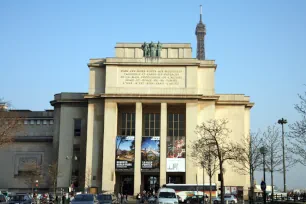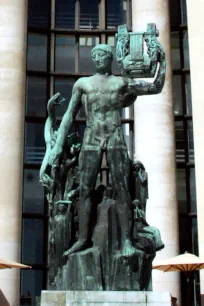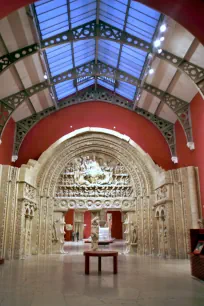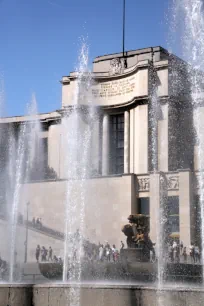A visit to the Palais de Chaillot provides an excellent view of the Eiffel Tower on the other side of the Seine. The monumental building is also worth a visit on its own merits: it houses several museums and an aquarium.
A Little History


The first structure built on the top of the hill known as Chaillot was erected for the 1878 World’s Fair. Known as the Palais du Trocadero, it was a large concert hall with two wings and two towers. An architecturally-unusual building, it contained elements of both Moorish and Byzantine architecture. An aquarium was situated below the building.
When it was announced that Paris would once again host the World’s Fair in 1937, plans for a new Palais de Chaillot were proposed. It was to be designed in “moderne” style by three architects: Louis-Hippolyte Boileau, Jacques Carlu and Léon Azéma.



Not unlike its predecessor, this building featured two wings that formed a wide arc, built on the foundations of the old palace. However, this time, the wings were not connected but were left independent. In the center is a wide esplanade that allows visitors to catch the best view in the city of the Eiffel Tower. Quotations by French poet and philosopher Paul Valéry decorate the buildings. Seven-meter-tall bronze statues of Apollo and Hercules stand in front of each wing.
Museums
Today, the Palais de Chaillot houses a number of different museums. In the south wing, there are two – the Musée de la Marine (Naval Museum) and the Musée de l’Homme (The Museum of Man). The former is a maritime-themed museum with a collection that started with artifacts belonging to Louis XV.
The Musée de l’Homme (Museum of Man), a museum of anthropology, strives to be a museum that can “define humanity” in a variety of different ways. It reopened October 17, 2015, after it was closed six years earlier. A selection of its collection moved to the Quai Branly museum, but it is still considered one of the world’s most important museums of anthropology.
There’s also an architecture museum – the Cité de l’architecture et du patrimoine, which opened in 2007. The museum showcases French architecture from the Middle Ages through the modern age. Its exhibits include the collection of the former Musée des Monuments Français (Museum of French Monuments) which boasts some 6,000 casts of sculptures of all periods, scale models of buildings, copies of architectural elements, and about 20,000 photographs.
The Théâtre National de Chaillot is located below the esplanade. With 1,200 seats, it was the center of Parisian culture following World War II and is still a popular location for concerts and plays.
There is also an aquarium located at the Palais de Chaillot, known as Cinéaqua. The aquarium, which bills itself as ‘not just an aquarium’ has 43 tanks with 10,000 fish and invertebrates, a shark tunnel, and even its own movie theaters. It is housed at the lower level of the Palais de Chaillot and can be accessed from the Trocadero gardens.
Jardins du Trocadéro
At the foot of the terrace of the Palais de Chaillot lie the Trocadero gardens. The ten hectare large gardens are laid out around a large rectangular pond. The fountain in the pond – the city’s largest – is especially spectacular at night, when it is lit.
- Next: Stravinsky Fountain
- More Sights & Attractions in Paris
- Related articles:

